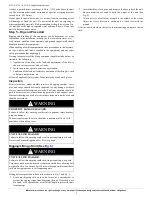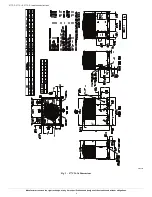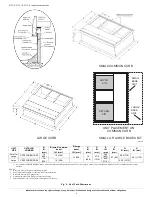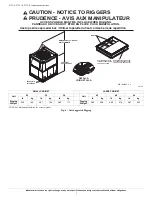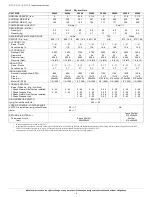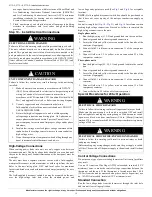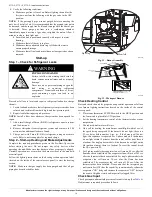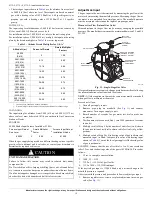
577C--C, 577C--E, 577C--F: Installation Instructions
Manufacturer reserves the right to change, at any time, specifications and designs without notice and without obligations.
2
Models with a N in the 13th position of the model number are dedicated
that are Low NOx units designed for California installations. These
models meet the California maximum oxides of nitrogen (NOx)
emissions requirements of 40 nanograms/joule or less as shipped from
the factory and must be installed in California Air Quality Management
Districts or any other regions in North America where a Low NOx rule
exists.
NOTE:
Low NOx requirements apply only to natural gas installations.
Receiving and Installation
Step 1 – Check Equipment
Identify Unit
The unit model number and serial number are stamped on the unit
information plate. Check this information against shipping papers.
Inspect Shipment
Inspect for shipping damage before removing packaging materials. If
unit appears to be damaged or is torn loose from its anchorage, have it
examined by transportation inspectors before removal. Forward claim
papers directly to transportation company. Manufacturer is not
responsible for any damage incurred in transit. Check all items against
shipping list. Immediately notify the nearest equipment distribution
office if any item is missing. To prevent loss or damage, leave all parts in
original packages until installation.
If the unit is to be mounted on a curb in a downflow application, review
Step 9 to determine which method is to be used to remove the downflow
panels before rigging and lifting into place. The panel removal process
may require the unit to be on the ground.
Step 2 – Provide Unit Support
For hurricane tie downs, contact distributor for details and PE
(Professional Engineering) Certificate if required.
Roof Curb
Install accessory roof curb in accordance with instructions shipped with
curb (See
). Install insulation, cant strips, roofing, and flashing.
Ductwork must be attached to curb.
IMPORTANT:
The gasketing of the unit to the roof curb is critical for a
water tight seal. Install gasketing material supplied with the roof curb.
Improperly applied gasketing also can result in air leaks and poor unit
performance.
Curb should be level to within 1/4 in. (6 mm). This is necessary for unit
drain to function properly. Refer to accessory roof curb installation
instructions for additional information as required.
Installation on older “G” series roof curbs.
Two accessory kits are available to aid in installing a new “G” series unit
on an old “G” roof curb.
1. Accessory kit number CPADCURB001A00, (small chassis) and
accessory kit number CPADCURB002A00, (large chassis) includes
roof curb adapter and gaskets for the perimeter seal and duct
openings. No additional modifications to the curb are required
when using this kit.
2. An alternative to the adapter curb is to modify the existing curb by
removing the outer horizontal flange and use accessory kit number
CPGSKTKIT001A00 which includes spacer blocks (for easy
alignment to existing curb) and gaskets for the perimeter seal and
duct openings. This kit is used when existing curb is modified by
removing outer horizontal flange.
Slab Mount
Place the unit on a solid, level pad that is at least 2 in. (51 mm) above
grade. The pad should extend approximately 2 in. (51 mm) beyond the
casing on all 4 sides of the unit. (See
.) Do not secure the unit to
the pad except when required by local codes.
A07926
Fig. 2 – Slab Mounting Details
Step 3 – Field Fabricate Ductwork
Secure all ducts to roof curb and building structure on vertical discharge
units. Do not connect ductwork to unit. For horizontal applications, unit
is provided with flanges on the horizontal openings. All ductwork should
be secured to the flanges. Insulate and weatherproof all external
ductwork, joints, and roof openings with counter flashing and mastic in
accordance with applicable codes.
Ducts passing through an unconditioned space must be insulated and
covered with a vapor barrier.
If a plenum return is used on a vertical unit, the return should be ducted
through the roof deck to comply with applicable fire codes.
Read unit rating plate for any required clearances around ductwork.
Cabinet return-air static shall not exceed -.25 IN. W.C.
Step 4 – Provide Clearances
IMPORTANT:
The unit must be secured to the curb by installing
screws through the bottom of the curb flange and into the unit base rails.
When installing large base units onto the common curb, the screws must
be installed before allowing the full weight of the unit to rest on the curb.
A minimum of six screws are required for large base units. Failure to
secure unit properly could result in an unstable unit. See Warning near
Rigging/Lifting information and accessory curb instructions for more
details.
The required minimum operating and service clearances are shown in
. Adequate combustion, ventilation and condenser air
must be provided.
IMPORTANT:
Do not restrict outdoor airflow. An air restriction at
either the outdoor-air inlet or the fan discharge may be detrimental to
compressor life.
The condenser fan pulls air through the condenser coil and discharges it
through the top grille. Be sure that the fan discharge does not recirculate
to the condenser coil. Do not locate the unit in either a corner or under an
overhead obstruction. The minimum clearance under a partial overhang
CAUTION
!
UNITS/STRUCTURAL DAMAGE HAZARD
Failure to follow this caution may result in property damage.
Ensure there is sufficient clearance for saw blade when cutting the outer
horizontal flange of the roof curb so there is no damage to the roof or
flashing.
OPTIONAL
RETURN
AIR
OPENING
OPTIONAL
SUPPLY
AIR
OPENING
EVAP. COIL
COND. COIL
2˝
(50.8mm)



